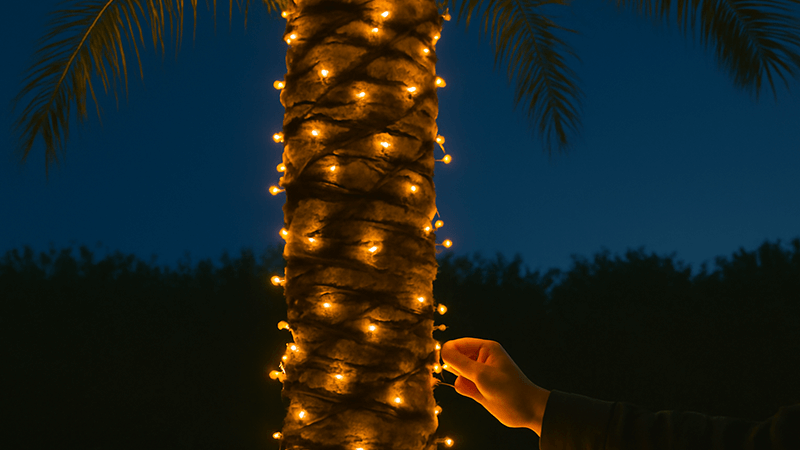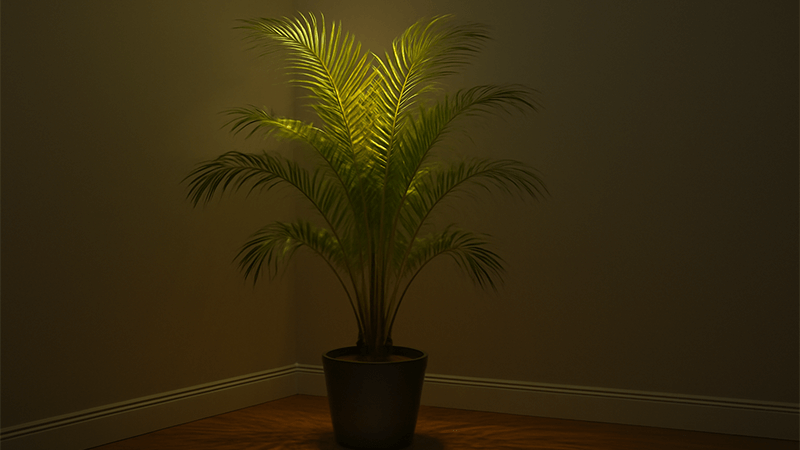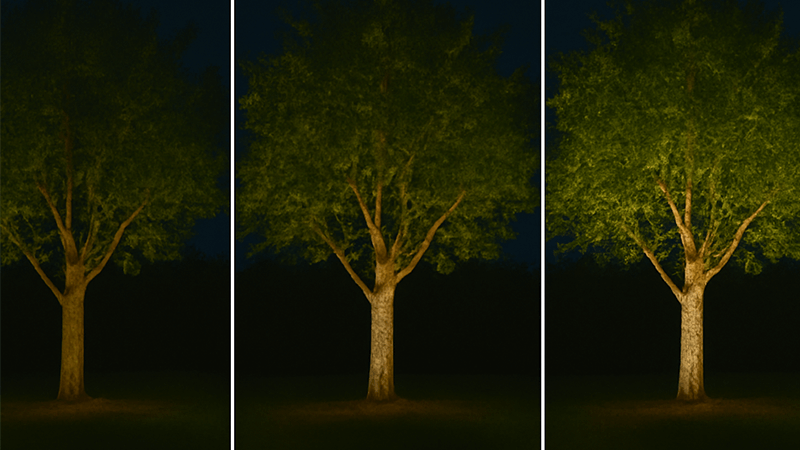Struggling to make your palm trees stand out after dark? A dark yard feels unwelcoming. Proper lighting can turn your palms into dramatic nighttime features, enhancing your entire landscape.
The best way to light up a palm tree is by using uplighting. Place one or more spotlights at the base, angled up to illuminate the trunk and fronds. This technique creates dramatic shadows and highlights the tree’s unique texture and shape, making it a beautiful focal point.

Uplighting is a great start, but it’s just one piece of the puzzle. Over my years in the lighting industry, I’ve seen many projects succeed or fail based on the small details. Getting the technique right is crucial. But there are more questions to answer before you can create that perfect nighttime oasis. Let’s explore some of the common challenges and questions I get from partners like Shaz in the UAE, starting with how to handle string lights.
When stringing lights on a tree, do you start at the top or bottom?
Confused about where to start wrapping your palm tree with string lights? Choosing the wrong starting point can lead to a tangled mess and an unprofessional, uneven finish.
Always start at the bottom of the palm tree when stringing lights. This allows you to securely anchor the plug end near the power source and wrap the lights upwards evenly. It’s safer, easier to manage the spool, and gives you better control over spacing.

Wrapping a tall, slender palm tree trunk with lights presents a unique challenge compared to traditional trees. As a manufacturer, I’ve seen how important the installation method is for the final look and longevity of the lights. Starting from the bottom is the universally accepted best practice for several key reasons. You are working with gravity, not against it. Trying to manage a spool of lights while on a ladder and wrapping downwards is a recipe for frustration. It’s also a significant safety concern. By starting on the ground, you establish a secure power connection first and can methodically work your way up.
The Professional’s Wrapping Technique
To get a clean, professional look, you need a plan. The spacing of the wraps is critical. For a tight, vibrant look, space the strands 2-3 inches apart. For a more subtle spiral, you might go 5-6 inches. Consistency is key.
Here is a simple process I recommend to our project contractors:
| Step |
Action |
Pro Tip |
| 1. Preparation |
Test all your string lights on the ground before you begin wrapping. |
It’s much easier to find and replace a bad bulb on the ground than halfway up a tree. |
| 2. Anchor the Start |
Securely fasten the beginning of the light string at the base of the trunk. |
Use a garden stake or a removable clip to keep the plug end neat and anchored. |
| 3. Wrap Upwards |
Begin wrapping the trunk, keeping the string taut and maintaining your desired spacing. |
To keep spacing even, use your hand width as a consistent guide as you spiral up the trunk. |
| 4. Secure the End |
Once you reach the desired height, securely fasten the end of the string. |
Use UV-resistant zip ties or clips that won’t damage the tree bark. This is vital in sunny, harsh climates. |
This bottom-up method ensures the final result is neat, secure, and easy to connect to your power source. It’s the same method professionals use to get that flawless, resort-style look.
Can a palm tree survive in low light?
Concerned your indoor palm isn’t getting enough sun? You see the leaves starting to yellow or droop, and you worry that the plant is slowly dying in that corner.
While palm trees are associated with bright, sunny climates, some species can tolerate and even thrive in low-light indoor conditions. Varieties like the Kentia Palm, Parlor Palm, and Bamboo Palm are well-adapted to survive with less direct sunlight, making them excellent houseplants.

This is a question I get surprisingly often, even from partners in sunny places like the UAE. Many projects involve lighting for large indoor atriums, lobbies, or residential spaces where people want the tropical feel of a palm tree without direct sunlight. The key is choosing the right species. Not all palms are created equal. A date palm that thrives in the desert will not survive in a dimly lit office. However, many understory palms have evolved to live under the canopy of larger trees, making them naturally suited for lower light. As a lighting professional, I find it’s just as important to understand the plant’s needs as it is to understand the lighting hardware. The goal is to use light to enhance the plant’s health and beauty, not just to illuminate it.
Selecting the Right Palm for Your Space
If you’re a purchasing manager like Shaz, specifying the right palm for an indoor project is the first step. Providing your clients with a list of suitable options shows a deeper level of expertise.
Here’s a breakdown of popular low-light tolerant palms:
| Palm Species |
Light Tolerance |
Watering Needs |
Key Feature |
| Kentia Palm |
Very high |
Allow soil to dry out between waterings |
Elegant and hardy, often called the "classic indoor palm." |
| Parlor Palm |
High |
Keep soil consistently moist, not soggy |
Compact size, perfect for smaller spaces and tabletops. |
| Bamboo Palm |
Medium to High |
Prefers consistently moist soil |
Grows in dense clusters, great for creating a lush screen. |
| Lady Palm |
High |
Water thoroughly when topsoil is dry |
Fan-shaped leaves, very elegant and slow-growing. |
Signs of Insufficient Light
Even low-light palms need some light. If the plant is not getting enough, it will show signs of stress. Look for yellowing fronds (especially older ones), slow or stunted growth, or "stretching" where the plant grows long and spindly towards the nearest light source. If you see these signs, try moving the plant to a spot with more indirect light or supplement with a grow light. The health of the palm is the foundation of any good lighting scheme.
How to illuminate a palm tree?
You have a beautiful palm, but just pointing a light at it doesn’t create the "wow" factor. It looks flat, or worse, creates ugly glare for anyone walking by.
To best illuminate a palm tree, use the uplighting technique. Place one to three spotlights at the base, aiming them up the trunk. This highlights the tree’s texture and the dramatic shape of the fronds, creating a stunning visual anchor in your landscape design.

In my experience manufacturing landscape lights, the most common mistake is using the wrong technique or the wrong number of fixtures. A single light can work for a very small, thin palm, but for most medium to large palms, it creates a one-dimensional, flat look. The magic comes from using light and shadow to create depth. This is where multiple fixtures make all the difference. By positioning lights at different angles around the base, you can "sculpt" the tree with light. This cross-lighting technique reveals the roundness of the trunk and catches different parts of the fronds, making the entire tree pop from the darkness. It’s also important to think about the viewing angles. Where will people see this tree from? The path, the house, the street? The placement of your lights should create a beautiful picture from all key viewpoints.
Mastering Palm Tree Illumination Techniques
The goal is to create a resort-quality look. This involves more than just pointing a fixture. It requires thinking about beam angle, color temperature, and fixture placement.
Here’s a guide to the most effective techniques I’ve shared with clients:
1. Classic Uplighting
This is the foundation of palm tree lighting. For a slender palm, one fixture is often enough. For a thicker, more mature palm, two or three fixtures are necessary to properly light the trunk and canopy.
- Fixture: LED Spotlights (like our FL-10 or FL-20 series).
- Placement: 1-3 feet from the base of the trunk.
- Angle: Aimed straight up the trunk to the fronds.
2. Cross-Lighting for Depth
This technique uses two or more lights from opposing sides to eliminate harsh shadows and reveal the tree’s full, three-dimensional shape.
- Fixtures: Two LED spotlights.
- Placement: Place them on opposite sides of the trunk, about 1-2 feet from the base.
- Angle: Aim them to cross paths on the trunk, highlighting the texture from multiple angles.
3. Combining with Other Layers
My insight for Shaz and other professionals is this: don’t light the palm tree in isolation. The most beautiful landscapes integrate multiple layers of light. Combine the dramatic uplighting of your palm tree with subtle path lighting, architectural facade lighting, and soft garden bed lighting. This creates a cohesive and harmonious scene, where the palm is the star, but the whole garden sings in unison. This holistic approach is what separates amateur work from a truly professional lighting design.
How many lumens to uplight a tree?
You’ve chosen your fixture, but now you face a choice of outputs. Too few lumens and the tree is barely visible. Too many, and it becomes a glaring beacon of light pollution.
For uplighting a tree, the required lumens depend on its size. For small trees (under 20 ft), 300-800 lumens is ideal. For medium trees (20-50 ft), use 800-1500 lumens. For large, mature trees (over 50 ft), you will need 1500 lumens or more per fixture.

This is one of the most practical questions I get from purchasing managers and contractors. They need to order the right product for the job. From a manufacturing perspective, we’ve developed fixtures with different lumen packages specifically for this reason. A common mistake is thinking "brighter is always better." This is rarely true in landscape lighting. The goal is to create an elegant ambiance, not replicate daylight. It’s about contrast. A tree will look brighter in a very dark rural setting than it will in a city with lots of ambient light. This is why having a range is important. I always advise clients like Shaz to consider the project’s specific environment. It’s better to have a fixture with adjustable output or to start on the lower end of the recommended range. You can always add more light, but overpowering a scene is a difficult mistake to fix.
Choosing the Right Brightness for Your Tree
The height and width of the tree’s canopy are the primary factors, but you must also consider the ambient light in the surrounding area. A tree in a dark backyard needs fewer lumens than the same tree in a brightly lit commercial complex.
Here is a quick reference table I use to help our partners specify the right fixtures:
| Tree Size |
Height |
Recommended Lumens (per fixture) |
Fixture Recommendation |
| Small |
Under 20 ft (6m) |
300 – 800 lm |
A single, narrow-beam spotlight. |
| Medium |
20 – 50 ft (6-15m) |
800 – 1500 lm |
One or two medium-beam spotlights. |
| Large / Mature |
Over 50 ft (15m+) |
1500 – 3000+ lm |
Two to three wider-beam spotlights. |
More Than Just Lumens: Beam Angle and Color Temperature
Lumens are only part of the story.
- Beam Angle: For a tall, narrow palm trunk, a narrow beam angle (15-24 degrees) is perfect. It concentrates the light vertically. For a wide canopy, you’ll want a wider beam angle (36-60 degrees) to evenly wash the fronds in light. Many projects use a narrow beam for the trunk and a wider beam for the canopy.
- Color Temperature: For most plants, a warm white light (2700K – 3000K) is best. It feels natural and enhances the green and brown tones of the tree, creating an inviting and sophisticated atmosphere. It mimics the warmth of sunset or firelight, which is what we are naturally drawn to in the evening.
By considering lumens, beam angle, and color temperature together, you can specify a lighting solution that is both technically correct and aesthetically beautiful.
Conclusion
By mastering uplighting techniques, choosing the right brightness, and integrating your palms into a complete landscape design, you can transform them from daytime features into spectacular nighttime focal points.